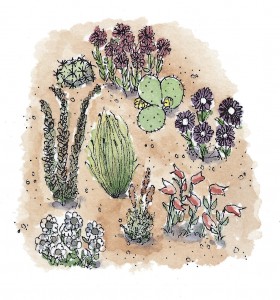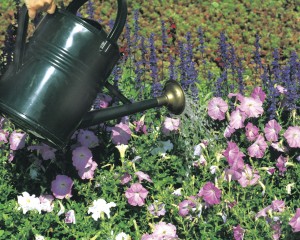Proper watering is key to healthy plants, happy environment
June 22, 2014The summer heat is about to hit. Proper watering techniques will ensure your gardens don’t take the brunt of the impact — and also conserve your liquid assets.

The first step, according to Rodale’s Organic Gardening, is determining the garden’s soil type: sand, loam or clay, or some combination thereof.
Loamy soils are usually the best for gardening — they retain just enough moisture, and also allow air spaces for the plants’ roots to “breathe.” They contain a good mix of sand, earth, and compost.
Sandy soils drain quickly and dry out rapidly. While that may be good for, say, cacti, it’s usually not the best choice for the types of vegetables and flowers grown in our region.
Soils made up of clay hold water the longest, but are also prone to retain so much moisture that a plants’ roots can rot.
Once you know your soil type, you can determine the best watering practices. Sandy soils will need more water, of course; clay soils much less. To determine if your plants need water, stick your finger about 1 inch into the soil. If you can feel moisture, the garden is good to go. If it’s dry, it’s time to add water. You should also watch your plants for signs of water stress – wilted leaves, drooping stems, etc. A little water stress can actually be good for some plants. Repeated drying-outs, however, with too long between waterings will leave a plan susceptible to disease and insects.
Prime times to water are in the morning or evening, before and after the sun’s rays cause moisture to evaporate. However, watering in the evening can promote fungal growth and disease if the humidity is high. Watering in the morning allows the plants to absorb what they need, and then lets the sun dry out the rest. Concentrate the water on the surface of the soil, not on the plants’ leaves — water droplets can magnify the sun’s rays, causing burn damage. Soaker hoses or a gentle shower from a garden hose work best. If the water is allowed to splash from the ground up onto the plant, it can transfer mold spores and disease to the leaves.
To maximize the effectiveness of watering, be sure to add mulch to the garden. If you don’t use chemicals on your lawn, grass clippings make an excellent mulch — they add nitrogen to the soil as they break down, and also keep down weeds while holding moisture in the soil.
 Choose the source of your water wisely. To maximize the benefits to your garden and the environment, use rain barrels to collect and store rainwater.
Choose the source of your water wisely. To maximize the benefits to your garden and the environment, use rain barrels to collect and store rainwater.
Finally, if you want to try an age-old method of creating a garden that retains and releases water as your plants need it, check out this earlier post about a technique called hugelkultur.